Diuraphis noxia (Kurdjumov)
Identification / Life Cycle
This small, lime green aphid has a football-shaped body, short antennae, and very short cornicles (Figure 7.1). Russian wheat aphid can be found at any time in the wheat crop. Winged adults migrate into wheat fields from the south. It is also common for resident populations that over-summer on wild grass species to give rise to small infestations in wheat that may be unnoticed in the fall. Russian wheat aphid can generally survive winter in the Great Plains, with the possible exception of North Dakota. Prolonged periods below 15°F (9°C), extended snow cover, and rapid freezing and thawing are detrimental to the aphid. Most economically important infestations occur in the spring. During the vegetative stages of wheat, these aphids feed on the newest leaves of the wheat plant within rolled leaves that provide a protected micro-habitat. However, they will also infest seedheads late in the season.
Figure 7.1 Russian wheat aphid.
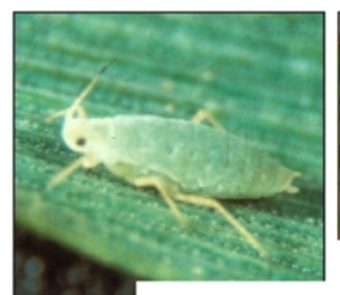
Figure 7.2 Leaf damage caused by the Russian wheat aphid.
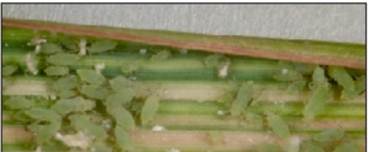
Plant Damage and Response
Infested leaves exhibit purple, yellow, or white longitudinal streaks along the leaves and leaf sheaths (Figure 7.2). Heavily infested plants may appear flattened, with prostrate young tillers (Figure 7.3). Later in the season infested leaves can trap emerging heads, preventing good grain fill (Figure 7.4).
Management
Establishing risk
Persistently high populations of Russian wheat aphid can lead to serious yield reduction and even plant death. Risk of yield loss is highest when infestations develop in early spring. In many areas,climatic conditions and biological control by predators, especially lady beetles, are normally quite effective in keeping them below damaging levels.
Scouting
Scouting wheat fields for infested tillers is the most effective way to determine the need to control Russian wheat aphid. Scout fields by randomly selecting tillers along a random path and examining them for the presence of live aphids and symptoms of Russian wheat aphid damage. Record the percentage of infested tillers. It is important to scout an area of the field large enough to determine the extent of the infestation. Scouting for Russian wheat aphid can be combined with scouting for greenbugs and other wheat pests as well.
Figure 7.3 Plant injury by the Russian wheat aphid.
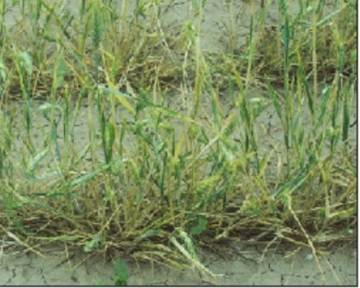
Figure 7.4 Russian wheat aphid feeding can cause emerging heads to become trapped.
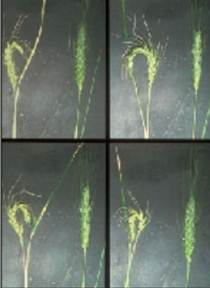
Thresholds in Fall
Populations that develop soon after the crop emerges in early fall can also be damaging. Extensive damage by the Russian wheat aphid in the fall can set plants up for reduced vigor and poor winter survival. This is more of a concern as winters become more harsh. In Kansas, Oklahoma, and Texas fall thresholds are 20 to 30 percent infested plants, while in Colorado, Nebraska, and Wyoming infestations of 10 to 20 percent infested plants may warrant treatment.
Thresholds in Spring
Economic thresholds for spring infestations of the Russian wheat aphid can be determined for varying treatment costs, yields, and prices by using the following formula:
If the percentage of infested tillers in the field exceeds the calculated threshold, then a treatment should be considered. After heading, use a factor of 500 rather than 200 in the numerator (see Table 7.1 for examples). Aphids are more likely to build up and impact heads if no rainfall occurs. Also, infestations confined to late-developing secondary tillers will have less impact on yield.
Chemical Control
It is important to only use insecticide treatments for control if the economic threshold has been reached. This will maintain effective suppression by natural enemies. Because Russian wheat aphid is well protected within curled leaves, control can be difficult. Chlorpyrifos is most effective at controlling these aphids. Other insecticides may be more effective if the aphids are exposed on the leaves or head. Also, if aphid infestations are well above the thresholds, control will be poorer and the potential for retreatment will increase.
Table 7.1 Calculated economic thresholds for fall and spring infestations of Russian wheat aphid.

Neonicotinoid seed treatments may provide protection through the fall. However, the cost of these treatments and the sporadic occurrence of the aphid in most areas limit the economic value of this strategy. These seed treatments may be warranted if the risk of fall infestation is high (e.g., near uncontrolled volunteer, early planted wheat, or alternate hosts for the aphid such as wheatgrasses, rangeland, or CRP).
Cu1tural Control
Elimination of volunteer wheat during the summer may help break the Russian wheat aphid life cycle by removing essential grass hosts for over-summering. Depriving the aphids of wheat through the summer can lower the abundance of aphids moving into wheat fields in the fall. Healthy, well watered plants are ofter able to withstand more aphid feeding than weak or drought stressed plants.
Biological Control
When the Russian wheat aphid invaded the United States an extensive program was established to import exotic parasitoids and predators in hopes of establishing new biocontrol agents. However, there has been little impact on the aphids by these agents. On the other hand, native parasitoids and predators seem to have adapted to Russian wheat aphid and now readily attack (Figure 7.5). Parasitoids that seem to be effective include the native Aphelinus varipes and the introduced species. A. albtpodus and A. asychis (Figure 7.6). Russian wheat aphid can also be parasitized by native Diaeretiella rapae and Lysiphlebus testaceipes, although parasitism rates are low. Ladybeetles (Hippodamia sp., Coccinella sp., and Scymnus sp.) are the primary predators of Russian wheat aphid and can effectively control infestations. However, it is possible that these predators work best when there are other aphids present in the field. Predateous syrphid flies and nabids will prey on Russian wheat aphid but seldom have a great impact.
Host Plant Resistance
In areas with a history of Russian wheat aphid problems, resistant varieties are a potential management option. Genetic sources of resistance developed in the late 1980s were eventually incorporated into commerical wheat varieties. One source is available in the variety Stanton (derived from PI 220350, containing the resistance gene designated Dny). The other resistance source is in the varieties Prowers 99, Prairie Red, Yumar, and several others (all derived from Pl372129, containing the resistance gene Dn4) (Refer to Chapter 3-"Variety Selection" for additional information and resources.
Figure 7.5 Parasitized Russian wheat aphids.

Figure 7.6 Wasp parasitoid (Aphelinus spp.).
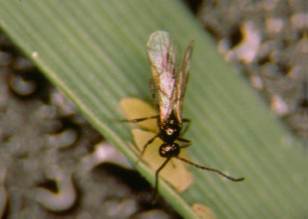
However, in 2003 a new biotype of the pest was detected in Colorado that was virulent to the resistance present in these varieties. This biotype is now widely distributed throughout eastern Colorado and surrounding states. The new biotype is capable of rapid population growth and can damage wheat very quickly, especially at warmer temperatures. The development of host plant resistance to Russian wheat aphid, as with most small grain aphids, is a continuing battle. New resistant cultivars and varieties will no doubt be developed over time.

